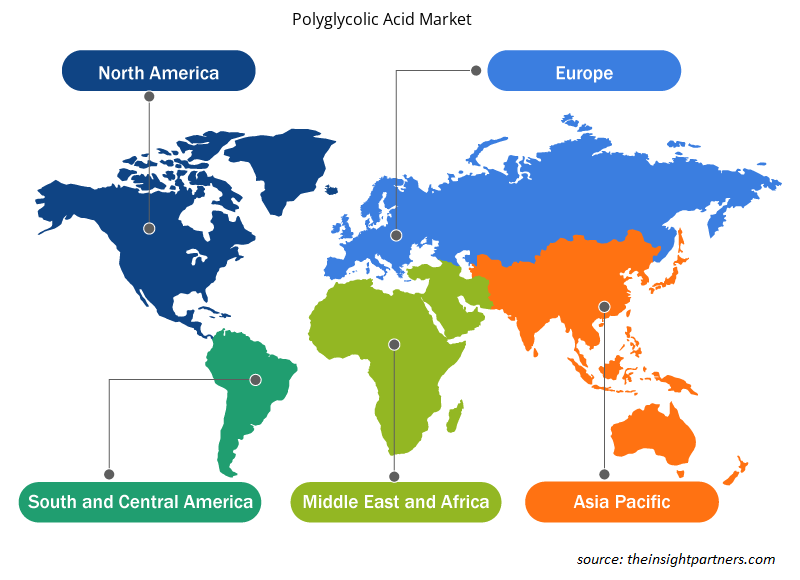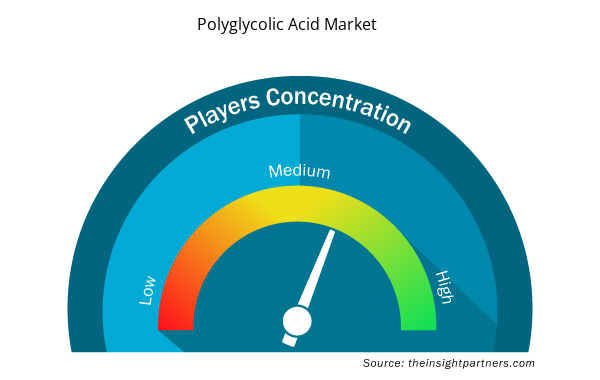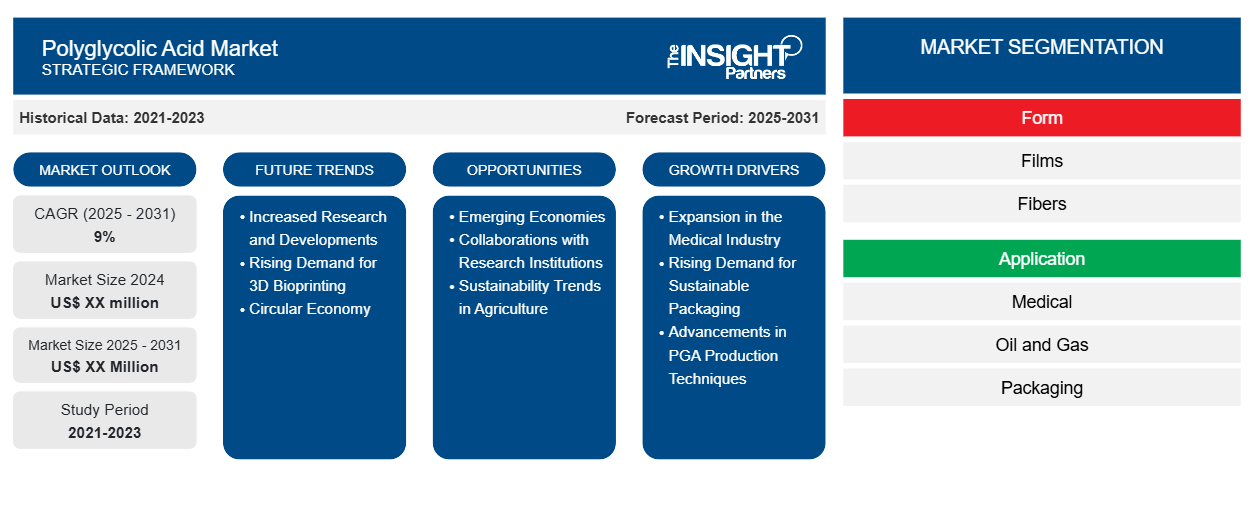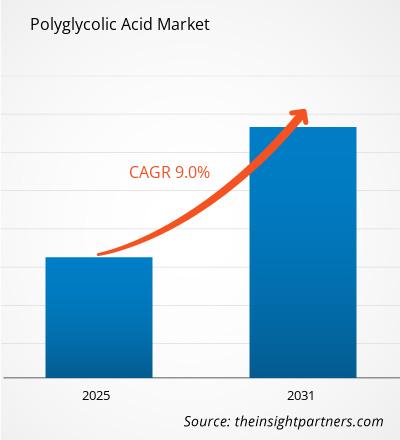Der Markt für Polyglykolsäure wird voraussichtlich von 2023 bis 2031 eine durchschnittliche jährliche Wachstumsrate (CAGR) von 9 % verzeichnen, wobei die Marktgröße von XX Millionen US-Dollar im Jahr 2023 auf XX Millionen US-Dollar im Jahr 2031 wachsen wird.Polyglycolic Acid Market is expected to register a CAGR of 9% from 2023 to 2031, with a market size expanding from US$ XX Million in 2023 to US$ XX Million by 2031.
Der Marktbericht zu Polyglykolsäure ist nach Form (Folien, Fasern und andere) segmentiert. Der Markt ist nach Anwendung segmentiert (Medizin, Öl und Gas, Verpackung und andere). Die globale Analyse ist weiter auf regionaler Ebene und in die wichtigsten Länder unterteilt. Die Marktgröße und -prognose auf globaler, regionaler und Länderebene für alle wichtigen Marktsegmente werden im Rahmen des Berichts behandelt. Der Bericht bietet den Wert in USD für die oben genannte Analyse, Segmente, Regionen und Länder. Der Bericht deckt Markttrends sowie Marktdynamiken wie Treiber, Beschränkungen und wichtige Chancen ab. Der Bericht deckt auch die Branchenlandschaft und Wettbewerbsanalyse ab, einschließlich Marktkonzentration, Heatmap-Analyse, prominenter Akteure und jüngster Entwicklungen auf dem Markt.
Zweck des Berichts
Der Bericht „Polyglykolsäuremarkt“ von The Insight Partners zielt darauf ab, die aktuelle Situation und das zukünftige Wachstum sowie die wichtigsten treibenden Faktoren, Herausforderungen und Chancen zu beschreiben. Dies wird verschiedenen Geschäftspartnern Einblicke geben, wie zum Beispiel:
- Technologieanbieter/-hersteller: Um die sich entwickelnde Marktdynamik zu verstehen und die potenziellen Wachstumschancen zu kennen, damit sie fundierte strategische Entscheidungen treffen können.
- Investoren: Durchführung einer umfassenden Trendanalyse hinsichtlich der Marktwachstumsrate, der finanziellen Marktprognosen und der Chancen entlang der Wertschöpfungskette.
- Regulierungsbehörden: Sie regulieren Richtlinien und polizeiliche Maßnahmen auf dem Markt mit dem Ziel, Missbrauch zu minimieren, das Vertrauen der Anleger zu bewahren und die Integrität und Stabilität des Marktes aufrechtzuerhalten.
Polyglykolsäure Marktsegmentierung
Bilden
- Filme
- Fasern
Anwendung
- Medizin
- Öl und Gas
- Verpackung
Passen Sie diesen Bericht Ihren Anforderungen an
Sie erhalten kostenlos individuelle Anpassungen an jedem Bericht, einschließlich Teilen dieses Berichts oder einer Analyse auf Länderebene, eines Excel-Datenpakets sowie tolle Angebote und Rabatte für Start-ups und Universitäten.
- Holen Sie sich die wichtigsten Markttrends aus diesem Bericht.Dieses KOSTENLOSE Beispiel umfasst eine Datenanalyse von Markttrends bis hin zu Schätzungen und Prognosen.
Wachstumstreiber auf dem Markt für Polyglykolsäure
- Expansion in der Medizinbranche: Einer der Hauptgründe für den Anstieg des Marktes für Polyglykolsäure (PGA) ist ihre weit verbreitete Verwendung im medizinischen Bereich, insbesondere bei der Herstellung von chirurgischem Nahtmaterial, Medikamentenverabreichungssystemen und Gewebezüchtung, um nur einige zu nennen. Studien haben gezeigt, dass PGA biokompatibel und bioabsorbierbar ist, was bedeutet, dass langlebige Prothesen aus diesem Material auf dem Markt nicht erhältlich sind. Mit verbesserter Gesundheitstechnologie und der Sicherheit bei orthopädischen Operationen wird die Verwendung des Biopolymers wahrscheinlich zunehmen.polyglycolic acid (PGA) market is its extensive use in the medical sector, especially in the manufacturing of surgical sutures, drug delivery systems, and tissue engineering, among other applications. Studies have shown that PGA is biocompatible and bioabsorbable which means longevity prosthesis made out of this material is not available in the market. With improved health care technology and orthopaedic surgeries safety, there is likely to be an increase in use of the biopolymer.
- Steigende Nachfrage nach nachhaltiger Verpackung: Aufgrund der steigenden Nachfrage nach nachhaltigen und kompostierbaren Lösungen besteht ein steigender Bedarf an Polyglykolsäure, insbesondere in Verpackungen. Die zunehmenden Verbote der Verwendung von Kunststoff für Verpackungen und die wachsende Vorliebe der Verbraucher für umweltfreundliche Materialien machen es in diesem Fall einfach, PGA zu verwenden. Zu seinen weiteren Eigenschaften gehören die biologische Abbaubarkeit und Leistung, die es auf dem Markt für umweltfreundliche Verpackungen sehr vorteilhaft machen.polyglycolic acid, especially in packaging, owing to the rising demand for sustainable and compostable solutions. The increasing bans on plastic use for packaging and the growing consumer preference for environmentally concerned materials make it easy to use PGA in this case. Its other attributes include biodegradability and performance which present it very favourably in the green packaging market.
- Fortschritte bei den PGA-Produktionstechniken: Darüber hinaus haben sich auch die Produktionsmethoden für Polyglykolsäure durch die Entwicklung neuer und schnellerer Methoden zur Herstellung der Verbindung und besserer Modifizierungstechniken verbessert, wodurch die Produktion verbessert und die Produktionskosten gesenkt wurden. Dies führt zu einer Tendenz zur Entwicklung einer effizienten Technologie für die Synthese hochwertiger Polysäure. Dieser Ansatz wird durch den verfügbaren Markt für diese Art von Polymer motiviert und trägt auch dazu bei, dieses spezielle Marktsegment voranzubringen.
Zukünftige Trends auf dem Markt für Polyglykolsäure
- Verstärkte Forschung und Entwicklung: Die Entwicklung von Mehrzweckderivaten aus Polyglykolsäure wird für Designer zu einem Werkzeug, um die Verbindung für einen bestimmten Zweck zu modifizieren. Forscher konzentrieren sich auf die Entwicklung von PGA-haltigen Zusammensetzungen und Mischungen mit dem Ziel, die mechanische Haltbarkeit, die Wärmebeständigkeit und andere funktionelle Eigenschaften zu verbessern. Dies wird wahrscheinlich dazu beitragen, neue Wege zur Verwendung von PGAs in anderen Bereichen außerhalb der Medizin zu finden, beispielsweise in der Verpackungs-, Landwirtschafts- und Biomedizinindustrie.
- Steigende Nachfrage nach 3D-Bioprinting: Der wachsende Trend zum 3D-Bioprinting dürfte enorme Chancen für den PGA-Markt schaffen. Angesichts des steigenden Bedarfs an spezifischen Tissue-Engineering-Produkten ist PGLA in 3D-Drucktechnologien auf Basis der regenerativen Medizin nützlich. Dies wird zu einem fortgeschrittenen Einsatz von IKT bei der Herstellung von Gerüsten für Gewebewachstum und -reparatur führen, was die Verwendung des Materials in der Biomedizin verbessern wird.
- Kreislaufwirtschaft: Das Bewusstsein für Nachhaltigkeit in der weltweiten Wirtschaft führt zu Veränderungen des traditionellen linearen Ansatzes hin zu den Prinzipien einer Kreislaufwirtschaft. Es geht auch darum, fortschrittliche und innovative, aber dennoch nachhaltige, vollständig biobasierte Produkte wie PGA zu schaffen. Da die Industrien darauf abzielen, den Kohlenstoffausstoß zu drosseln und den Abfall zu reduzieren, wird die produktive Konstruktionshülle der Verbundwerkstoffe von American-PGA integriert und daher auf den meisten Märkten akzeptiert.
Marktchancen für Polyglykolsäure
- Schwellenländer: Die Regionen Asien-Pazifik und Lateinamerika sind vielversprechend für den Markt für Polyglykolsäure, da es in diesen Regionen Schwellenländer gibt. Mit der industriellen Entwicklung und den steigenden Investitionen in das Gesundheitswesen in diesen Regionen wird der Umfang biologisch abbaubarer Materialien und fortschrittlicher medizinischer Anwendungen zunehmen. Dieser Trend ist für Unternehmen von Vorteil, da er es ihnen ermöglicht, in diesen Märkten Produktionsanlagen zu bauen oder Partnerschaften einzugehen.
- Zusammenarbeit mit Forschungseinrichtungen: Durch die Zusammenarbeit mit Forschungsinstituten und Universitäten ist es möglich, die Innovation in Anwendungsbereichen und die Produktionstechnologien für PGA zu fördern. Dies erleichtert die Herstellung innovativer Produkte mit einzigartigen Anwendungen wie PGA-Medizin, Verpackung und Landwirtschaft. Diese Strategie kann hilfreich sein, um die Wettbewerbsfähigkeit auf dem Markt zu steigern und Schlüsselakteure über einen langen Zeitraum zu fördern.
- Nachhaltigkeitstrends in der Landwirtschaft: Im Agrarsektor sind die Aussichten für PGA enorm, insbesondere bei der Anwendung biologisch abbaubarer Mulchfolien, Saatgutbeschichtungen sowie kontrolliert freigesetzter Düngemittel. Da die Welt in Richtung nachhaltiger Praktiken in der Landwirtschaft geht, erfordert die Abfallreduzierung durch Kunststoffmaterialien in der Landwirtschaft den Einsatz biologisch abbaubarer Produkte wie PGA. Daher ist dies eine Gelegenheit für Unternehmen, ihre Produkte zu diversifizieren und den aufstrebenden Markt zu nutzen.
Regionale Einblicke in den Markt für Polyglykolsäure
Die regionalen Trends und Faktoren, die den Markt für Polyglykolsäure im Prognosezeitraum beeinflussen, wurden von den Analysten von Insight Partners ausführlich erläutert. In diesem Abschnitt werden auch die Marktsegmente und die Geografie für Polyglykolsäure in Nordamerika, Europa, im asiatisch-pazifischen Raum, im Nahen Osten und Afrika sowie in Süd- und Mittelamerika erörtert.

- Erhalten Sie regionale Daten zum Polyglykolsäuremarkt
Umfang des Marktberichts über Polyglykolsäure
| Berichtsattribut | Details |
|---|---|
| Marktgröße im Jahr 2024 | XX Millionen US-Dollar |
| Marktgröße bis 2031 | XX Millionen US-Dollar |
| Globale CAGR (2024 - 2031) | 9 % |
| Historische Daten | 2021-2023 |
| Prognosezeitraum | 2025–2031 |
| Abgedeckte Segmente | Nach Formular
|
| Abgedeckte Regionen und Länder | Nordamerika
|
| Marktführer und wichtige Unternehmensprofile |
|
Dichte der Marktteilnehmer für Polyglykolsäure: Deren Auswirkungen auf die Geschäftsdynamik verstehen
Der Markt für Polyglykolsäure wächst rasant, angetrieben durch die steigende Nachfrage der Endverbraucher aufgrund von Faktoren wie sich entwickelnden Verbraucherpräferenzen, technologischen Fortschritten und einem größeren Bewusstsein für die Vorteile des Produkts. Mit steigender Nachfrage erweitern Unternehmen ihr Angebot, entwickeln Innovationen, um die Bedürfnisse der Verbraucher zu erfüllen, und nutzen neue Trends, was das Marktwachstum weiter ankurbelt.
Die Marktteilnehmerdichte bezieht sich auf die Verteilung von Firmen oder Unternehmen, die in einem bestimmten Markt oder einer bestimmten Branche tätig sind. Sie gibt an, wie viele Wettbewerber (Marktteilnehmer) in einem bestimmten Marktraum im Verhältnis zu seiner Größe oder seinem gesamten Marktwert präsent sind.
Die wichtigsten auf dem Markt für Polyglykolsäure tätigen Unternehmen sind:
- B. Braun Melsungen AG
- BMG Incorporated
- Corbion NV
- DemeTech-Nähte
- Evonik Industries
Haftungsausschluss : Die oben aufgeführten Unternehmen sind nicht in einer bestimmten Reihenfolge aufgeführt.

- Überblick über die wichtigsten Akteure auf dem Polyglykolsäuremarkt
Wichtige Verkaufsargumente
- Umfassende Abdeckung: Der Bericht deckt die Analyse von Produkten, Dienstleistungen, Typen und Endbenutzern des Polyglykolsäure-Marktes umfassend ab und bietet einen ganzheitlichen Überblick.
- Expertenanalyse: Der Bericht basiert auf dem umfassenden Verständnis von Branchenexperten und Analysten.
- Aktuelle Informationen: Der Bericht stellt durch die Abdeckung aktueller Informationen und Datentrends Geschäftsrelevanz sicher.
- Anpassungsoptionen: Dieser Bericht kann angepasst werden, um spezifische Kundenanforderungen zu erfüllen und die Geschäftsstrategien optimal anzupassen.
Der Forschungsbericht zum Markt für Polyglykolsäure kann daher dabei helfen, die Branchensituation und Wachstumsaussichten zu entschlüsseln und zu verstehen. Obwohl es einige berechtigte Bedenken geben kann, überwiegen die allgemeinen Vorteile dieses Berichts tendenziell die Nachteile.
- Historische Analyse (2 Jahre), Basisjahr, Prognose (7 Jahre) mit CAGR
- PEST- und SWOT-Analyse
- Marktgröße Wert/Volumen – Global, Regional, Land
- Branche und Wettbewerbsumfeld
- Excel-Datensatz



Report Coverage
Revenue forecast, Company Analysis, Industry landscape, Growth factors, and Trends

Segment Covered
This text is related
to segments covered.

Regional Scope
North America, Europe, Asia Pacific, Middle East & Africa, South & Central America

Country Scope
This text is related
to country scope.
Häufig gestellte Fragen
Development of multifunctional PGA derivatives is expected to be the key market trends.
Based on application, the medical segment is expected to witness the fastest growth during the forecast period.
Based on geography, Asia Pacific held the largest share of the polyglycolic acid market due to the strong growth of the packaging and medical industry.
Increasing demand in the medical sector is driving the market growth.
KUREHA CORPORATION, Corbion, The Chemours Company, Merck KGaA, Shenzhen Polymtek Biomaterial Co, Ltd., BMG Incorporated, Teleflex Incorporated, Advanced Medical Solutions Group PLC., Biomaterial Co. Ltd., and Foryou Medical are the key players operating in the polyglycolic acid market.
The Polyglycolic Acid Market is estimated to witness a CAGR of 9% from 2023 to 2031
Trends and growth analysis reports related to Chemicals and Materials : READ MORE..
1. B. Braun Melsungen AG
2. BMG Incorporated
3. Corbion NV
4. DemeTech Sutures
5. Evonik Industries
6. Kureha Corporation
7. Orion Sutures India Pvt. Ltd
8. Sigma-Aldrich, Inc. (Merck KGaA)
9. Teleflex Incorporated
10. The Chemours Company
The Insight Partners performs research in 4 major stages: Data Collection & Secondary Research, Primary Research, Data Analysis and Data Triangulation & Final Review.
- Data Collection and Secondary Research:
As a market research and consulting firm operating from a decade, we have published and advised several client across the globe. First step for any study will start with an assessment of currently available data and insights from existing reports. Further, historical and current market information is collected from Investor Presentations, Annual Reports, SEC Filings, etc., and other information related to company’s performance and market positioning are gathered from Paid Databases (Factiva, Hoovers, and Reuters) and various other publications available in public domain.
Several associations trade associates, technical forums, institutes, societies and organization are accessed to gain technical as well as market related insights through their publications such as research papers, blogs and press releases related to the studies are referred to get cues about the market. Further, white papers, journals, magazines, and other news articles published in last 3 years are scrutinized and analyzed to understand the current market trends.
- Primary Research:
The primarily interview analysis comprise of data obtained from industry participants interview and answers to survey questions gathered by in-house primary team.
For primary research, interviews are conducted with industry experts/CEOs/Marketing Managers/VPs/Subject Matter Experts from both demand and supply side to get a 360-degree view of the market. The primary team conducts several interviews based on the complexity of the markets to understand the various market trends and dynamics which makes research more credible and precise.
A typical research interview fulfils the following functions:
- Provides first-hand information on the market size, market trends, growth trends, competitive landscape, and outlook
- Validates and strengthens in-house secondary research findings
- Develops the analysis team’s expertise and market understanding
Primary research involves email interactions and telephone interviews for each market, category, segment, and sub-segment across geographies. The participants who typically take part in such a process include, but are not limited to:
- Industry participants: VPs, business development managers, market intelligence managers and national sales managers
- Outside experts: Valuation experts, research analysts and key opinion leaders specializing in the electronics and semiconductor industry.
Below is the breakup of our primary respondents by company, designation, and region:

Once we receive the confirmation from primary research sources or primary respondents, we finalize the base year market estimation and forecast the data as per the macroeconomic and microeconomic factors assessed during data collection.
- Data Analysis:
Once data is validated through both secondary as well as primary respondents, we finalize the market estimations by hypothesis formulation and factor analysis at regional and country level.
- Macro-Economic Factor Analysis:
We analyse macroeconomic indicators such the gross domestic product (GDP), increase in the demand for goods and services across industries, technological advancement, regional economic growth, governmental policies, the influence of COVID-19, PEST analysis, and other aspects. This analysis aids in setting benchmarks for various nations/regions and approximating market splits. Additionally, the general trend of the aforementioned components aid in determining the market's development possibilities.
- Country Level Data:
Various factors that are especially aligned to the country are taken into account to determine the market size for a certain area and country, including the presence of vendors, such as headquarters and offices, the country's GDP, demand patterns, and industry growth. To comprehend the market dynamics for the nation, a number of growth variables, inhibitors, application areas, and current market trends are researched. The aforementioned elements aid in determining the country's overall market's growth potential.
- Company Profile:
The “Table of Contents” is formulated by listing and analyzing more than 25 - 30 companies operating in the market ecosystem across geographies. However, we profile only 10 companies as a standard practice in our syndicate reports. These 10 companies comprise leading, emerging, and regional players. Nonetheless, our analysis is not restricted to the 10 listed companies, we also analyze other companies present in the market to develop a holistic view and understand the prevailing trends. The “Company Profiles” section in the report covers key facts, business description, products & services, financial information, SWOT analysis, and key developments. The financial information presented is extracted from the annual reports and official documents of the publicly listed companies. Upon collecting the information for the sections of respective companies, we verify them via various primary sources and then compile the data in respective company profiles. The company level information helps us in deriving the base number as well as in forecasting the market size.
- Developing Base Number:
Aggregation of sales statistics (2020-2022) and macro-economic factor, and other secondary and primary research insights are utilized to arrive at base number and related market shares for 2022. The data gaps are identified in this step and relevant market data is analyzed, collected from paid primary interviews or databases. On finalizing the base year market size, forecasts are developed on the basis of macro-economic, industry and market growth factors and company level analysis.
- Data Triangulation and Final Review:
The market findings and base year market size calculations are validated from supply as well as demand side. Demand side validations are based on macro-economic factor analysis and benchmarks for respective regions and countries. In case of supply side validations, revenues of major companies are estimated (in case not available) based on industry benchmark, approximate number of employees, product portfolio, and primary interviews revenues are gathered. Further revenue from target product/service segment is assessed to avoid overshooting of market statistics. In case of heavy deviations between supply and demand side values, all thes steps are repeated to achieve synchronization.
We follow an iterative model, wherein we share our research findings with Subject Matter Experts (SME’s) and Key Opinion Leaders (KOLs) until consensus view of the market is not formulated – this model negates any drastic deviation in the opinions of experts. Only validated and universally acceptable research findings are quoted in our reports.
We have important check points that we use to validate our research findings – which we call – data triangulation, where we validate the information, we generate from secondary sources with primary interviews and then we re-validate with our internal data bases and Subject matter experts. This comprehensive model enables us to deliver high quality, reliable data in shortest possible time.


 Holen Sie sich ein kostenloses Muster für diesen Bericht
Holen Sie sich ein kostenloses Muster für diesen Bericht